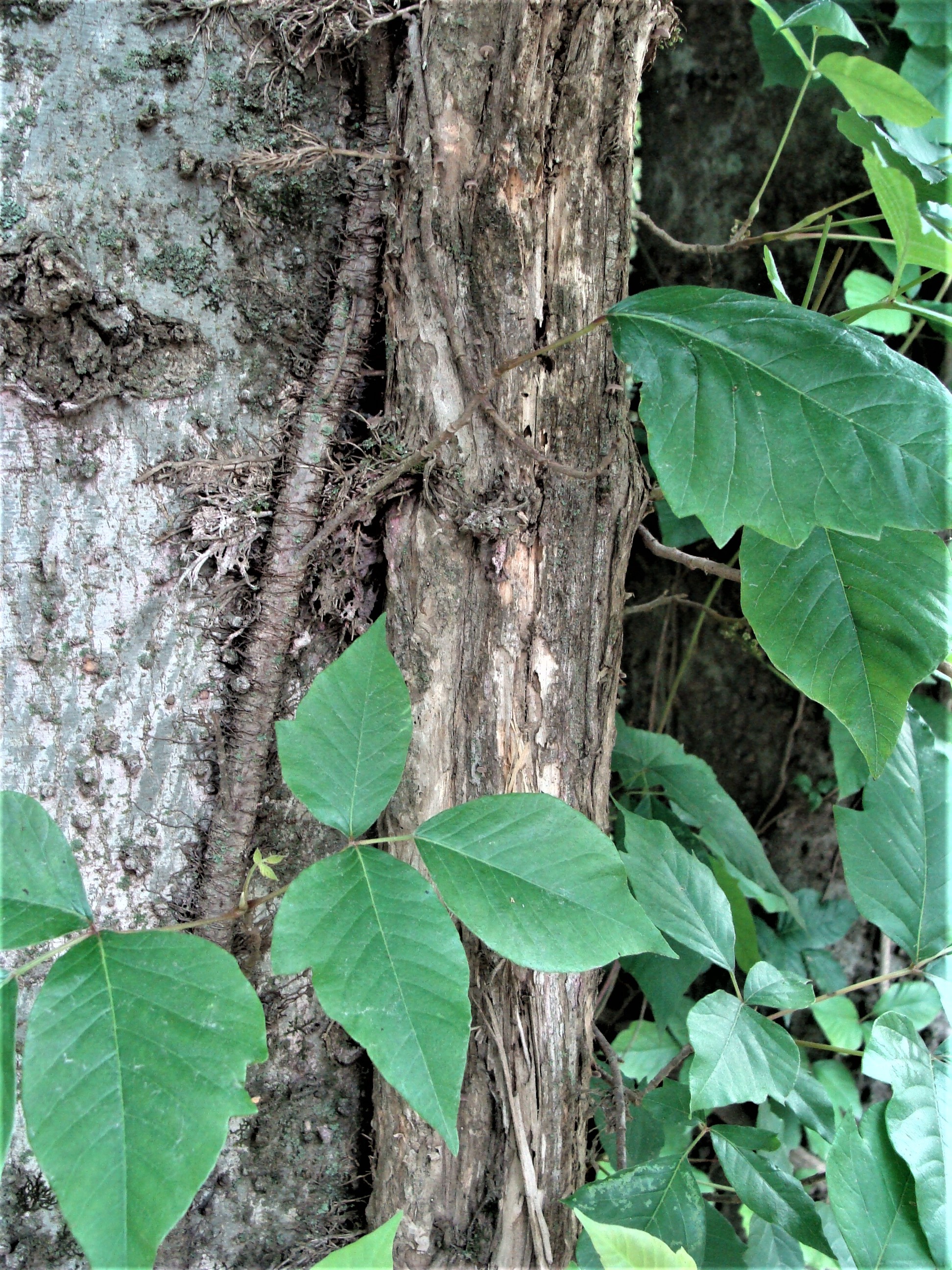Trumpet Vine or Trumpet Creeper (Campsis radicans) of the Trumpet Creeper (Bignoniaceae) family is a non-twining, tendril-free, woody vine with spectacular, large, orange to red, trumpet-shaped flowers. The genus name is Greek for “curved,” a reference to the curved stamens. The specific epithet is from Latin for “taking root” in reference to the aerial rootlets that bind the climbing plant to its host. In the U.S., Trumpet Vine is native from Oklahoma and eastern Kansas to the Atlantic and Gulf Coasts as well as in scattered areas in Texas. Naturalized occurrences extend west and east across the country to as far as Washington State and Vermont. In Arkansas, the species is recorded from every county. Habitats include a wide variety of soils in sun and shade: well-drained to moist woodlands, woodland edges, fields, rights-of-way, fences and fencerows. Vines not only climb, they trail along the ground, sprawling and clambering over themselves and other plants and structures.
Mature plants in sunny sites produce two growth forms: trailing, fast-growing, limber to woody, non-flowering vines to 25+ feet long that grow along the ground and over other plants and structures, often producing terrestrial and aerial (clinging) roots at the nodes. And rigid to woody, somewhat self-supporting, arching vines to 6+ feet long that extend outward from these vegetative stems. Depending on space, sunlight, and presence of supporting objects, a plant may develop into a wide-spreading, dense, elevated groundcover and/or an aggressive liana climbing trees, fences, and even buildings. Wide-spreading woody roots may produce ascending suckers well away from a plant’s point of origin.






Old plants, established at the base of large trees, tend to have one to a few trunks which may grow to 3-5 inches in diameter. As vines age over multiple years, the bark exfoliates in narrow strips and becomes moderately fissured.


Current-year vines bear widely spaced, decussate, opposite, odd-pinnately (with a single terminal leaflet) compound leaves. Leaflets are ovate to broadly lanceolate with rounded to cuneate base and long-acuminate to acute apex. Leaves have 7-13 leaflets, shiny, dark green, and glabrous above and dull, yellowish green, and minutely pubescent beneath. A 7-leaflet leaf may be 7 inches long (including a 1½ inch petiole) and 4½ inches wide with leaflets that are to 3 inches long and 1½ inches wide. Petioles may have a half-dozen tiny nectary pits along their swollen bases. Leaflet margins are coarsely serrate. Terminal leaflet blade is symmetric while lateral leaflets tend to have oblique bases.



Flowers, from June into August, first appear as small ovoid buds. The terminal, cymose inflorescence bears opposite pairs of stubby peduncles that produce pairs of short, stubby branches. Each branch bears a simple cyme of three flowers, one terminal and a pair of laterals, with the terminal flower blooming first. Often, pedicels or flower buds abscise so that compound cymes become knobby. Plants in full sun flower more profusely.




In bloom, the calyx of Trumpet Vine flowers is orange, the corolla outwardly orange to reddish. The flowers are spectacular and the vines cultivated worldwide for their decorative appeal. The corolla is slightly irregular, that is, bilaterally symmetrical. The tube measures about 3 inches long and tapers from about an inch at the tip to ¼ inch within calyx. Prominent red nectar guide-lines extend upward within the yellowish interior of the tube. Corollas remain open for a single day, after which, the entire corolla (and the stamens attached to the tube within) is shed, often littering the ground with color beneath high-climbing vines. Flowers are a favorite of bumblebees, sphinx moths, and hummingbirds.

Flowers have 4 functional stamens (filament + anther) and 1 sterile, vestigial stamen or staminode, the filaments attached not to the receptacle but to the inner wall of the corolla tube. The curved, sturdy, pollen-producing stamens are in two pairs of two lengths. Just within the mouth of the corolla, anthers and stigma are pressed against the upper surface of the tube, perfectly positioned to deposit pollen on and to receive pollen from the heads and bodies of pollinators as they enter the tube for nectar.
The 2-chambered, superior ovary is borne on a prominent, nectar-secreting disc. The pale-green style terminates with a flat, folded stigma which, when receptive to pollen, spreads wide into 2 thin, flaplike lobes (⅛ x ⅛ inch) to expose stigmatic surfaces. In addition to outcrossing by cross-pollination, self-pollination commonly occurs. With sufficient pollen load, the active stigma flaps press together.*




Fertilized flowers produce a large, bean-like capsule, green at first and eventually tan. Of the many flowers in a large inflorescence, few flowers produce capsules. Mature capsules, to 3-6 inches long and 1 inch wide, are straight to slightly curved, with an opposite pair of prominent, longitudinal ridges that mark the sutures. Capsules open at the sutures by two valves. A septum, perpendicular to the valves, supports a pair of placentas in each of the 2 chambers at the junction of the septum to the capsule walls. Being thick-walled and packed tightly with numerous seeds, the bulging capsules are heavy and pendulous on the vine. Exterior of capsules is smooth and glabrous with a few scattered pores that provide nectar to ants. Dry, woody capsules persist well into winter as the valves slowly dehisce to release layers of thin, flat seeds. The airborne seeds with translucent wings measure about ⅝ by ¼ inch. The gaping valves of empty capsules remain on vines into spring.



Although Trumpet Vine has attractive leaves and especially showy flowers, the plant is probably too large and aggressive to be added to most gardens. With continuous pruning and removal of rooted suckers, plants have the potential to be attractive on arbors and trellises. In sunny sites, the plant’s tangled and dense growth habit can provide erosion control and nesting sites for birds as well as protection for birds and small mammals. Plants are less vigorous in more shaded sites and produce fewer flowers. Trumpet Vine is a great plant for hummingbirds. Vines attaching to walls and roofs can cause damage. For some people, sap can cause skin irritation.
The only other species in the genus Campsis is Chinese Trumpet Vine (C. grandiflora), a native of Eastern Asia––and the two species are an example of what plant geographers call the Chinese-American disjunction. (The two species worldwide of Liriodendron are another example of this intriguing distribution pattern.) In the U.S., Trumpet Vine may be confused with another, closely related, high-climbing, woody vine, Cross Vine (Bignonia capreolata). However, Cross Vine has tendrils, 2-leaflet compound leaves and, typically, reddish tubular flowers with lobes that are yellow on the inside.
* For a detailed study of pollination, see: https://www.jipb.net/EN/Y2004/V46/I9/1071
Article and photographs by ANPS member Sid Vogelpohl

